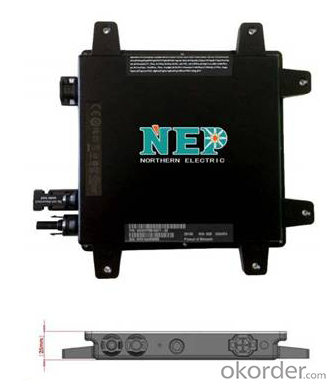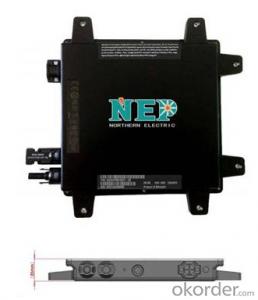Abb Solar Inverter Micro-Inverter BDM-300
- Loading Port:
- Qingdao
- Payment Terms:
- TT OR LC
- Min Order Qty:
- 10 unit
- Supply Capability:
- 1000 unit/month
OKorder Service Pledge
OKorder Financial Service
You Might Also Like
Description:
A solar micro-inverter, converts direct current (DC) electricity from a single solar panel to alternating current (AC). The electric power from several micro-inverters is combined and fed into an existing electrical grid. Micro-inverters contrast with conventional string or central inverter devices, which are connected to multiple solar panels.
Characteristic & Advantages:
More Energy Harvest: Distributed MPPT allows10~25% more energy harvest
Simple: Modularized,single ac cable to the house
Reliability: Longer life time and almost 100% operation hours
Security: No high Voltage, makes safter environments
Inteligent : Monitoring each module
Savings: No dc components and significantly save labor cost

MODEL | BDM-300-240A | BDM-300-208A | BDM-300-EU BDM-300-AU | |||
INPUT(DC) | Max Recommended PV Power (Wp) | 310 | ||||
Max DC Open Circuit Voltage (Vdc) | 60 | |||||
Max DC Input Current (Adc) | 12 | |||||
MPPT Tracking Accuracy | >99.5% | |||||
MPPT Tracking Range (Vdc) | 22-55 | |||||
Isc PV (absolute maximum) (Adc) | 14 140 | |||||
Maximum Inverter Backfeed Current to the Array (Adc) | 0 0 | |||||
OUTPUT(AC) | Rated AC Output Power (Wp) | 250 | ||||
Nominal Power Grid Voltage (Vac) | 240 | 208 | 230 | |||
Allowable Power Grid Voltage (Vac) | 211-264* | 183-229* | configurable | |||
Allowable Power Grid Frequency (Hz) | 59.3-60.5* | configurable | ||||
THD | <3% (at rated power) / | |||||
Power Factor (cos phi, fixed) | >0.99 (at rated power) | |||||
Current (maximum continuous) (Aac) | 1.2 | |||||
Current (inrush) (Peak and Duration) | 12A, 15us | |||||
Nominal Frequency (Hz) | 60 | 50 | ||||
Maximum Output Fault Current (Aac) | 2.2A peak | |||||
Maximum Output Overcurrent Protection (Aac) | 6.3 | |||||
Maximum Number of Units Per Branch | 16 (12AWG); 12 (14AWG) | |||||
SYSTEM EFFICIENCY | Peak Efficiency | 96.30% | 96.30% | 95.80% | ||
CEC Efficiency | 95.5% | |||||
Night Time Tare Loss (Wp) | 0.08 | 0.06 | 0.07 | |||
PROTECTION FUNCTIONS | Over/Under Voltage Protection | Yes | ||||
Over/Under Frequency Protection | Yes | |||||
Anti-Islanding Protection | Yes | |||||
Over Current Protection | Yes | |||||
Reverse DC Polarity Protection | Yes | |||||
Overload Protection | Yes | |||||
Protection Degree | NEMA-6 / IP-67 I | |||||
Environment Temperature | -40℃——+65℃ | |||||
OTHER PARAMETERS | Environment Humidity | 100%, condensation | ||||
Display | LED LIGHT | |||||
Communications | Power Line | |||||
Dimension (D-W-H mm) | 180*186*25 | |||||
Weight (Kg) | 1.5 | |||||
Environment Category | Indoor and outdoor | |||||
Wet Location | Suitable | |||||
Pollution Degree | PD 3 | |||||
Maximum Altitude | 2000 M | |||||
Overvoltage Category | II(PV), III (AC MAINS) | |||||
Product Safety Compliance | UL 1741 CSA C22.2 No. 107.1 | IEC/EN 62109-1 IEC/EN 62109-2 | ||||
Grid Code Compliance* (Refer to the label for the detailed grid code compliance) | IEEE 1547 | VDE-AR-N 4105* VDE V 0126-1-1/A1 G83/2, CEI 021 AS 4777.2 & AS 4777.3
| ||||
Note: For grid code VDE-AR-N 4105, maximum 3.68kVA PV plant is limited. The grid protection report and setting are readable from the gateway. For grid code G83/2, maximum 16A per phase is limited. The grid protection report and setting are readable from the gateway. Grid parameters are configurable through the BDG-256 gateway. | ||||||
- Q: Can a solar inverter be used with concentrated solar power systems?
- Yes, a solar inverter can be used with concentrated solar power systems. Concentrated solar power (CSP) systems use mirrors or lenses to concentrate sunlight onto a receiver, which then converts the sunlight into heat. This heat can then be used to generate electricity through various means, including steam turbines. In order to convert this heat-generated electricity into the required alternating current (AC) for use in homes and businesses, a solar inverter is needed. Therefore, a solar inverter is an essential component in connecting and integrating the electricity generated by concentrated solar power systems into the power grid.
- Q: How is the efficiency of a solar inverter measured?
- The efficiency of a solar inverter is typically measured by dividing the output power of the inverter by the input power, and then multiplying the result by 100 to get a percentage value.
- Q: Can a solar inverter be integrated with a smart home system?
- Yes, a solar inverter can be integrated with a smart home system. Many modern solar inverters have built-in communication capabilities, such as Wi-Fi or Ethernet, which allow them to connect to a smart home system. This integration enables homeowners to monitor and control their solar power production and energy consumption conveniently through a centralized smart home platform. They can track energy production, set energy usage preferences, and even automate certain functions based on available solar power.
- Q: Can a solar inverter be used with different brands of solar panels?
- Yes, a solar inverter can generally be used with different brands of solar panels as long as they have compatible specifications and operating voltages. However, it is important to consult the manufacturer's guidelines or seek professional advice to ensure compatibility and optimal performance.
- Q: What is the role of MPPT (Maximum Power Point Tracking) in a solar inverter?
- The role of MPPT (Maximum Power Point Tracking) in a solar inverter is to optimize the efficiency and output of the solar panel system. MPPT technology enables the inverter to constantly track and adjust the operating point of the panels, ensuring that they are operating at their maximum power point, where the highest power output is achieved. This allows the system to capture the maximum amount of energy from the sun, maximizing the overall efficiency and performance of the solar inverter.
- Q: What is the role of an MPPT (Maximum Power Point Tracking) inverter?
- The role of an MPPT (Maximum Power Point Tracking) inverter is to optimize the energy output of solar panels by constantly adjusting the voltage and current to operate at the maximum power point (MPP) of the photovoltaic array. This allows the inverter to efficiently convert the DC power generated by the solar panels into AC power for use in homes or businesses. By continuously tracking and adjusting the operating point of the solar panels, MPPT inverters maximize the energy harvest and improve the overall performance of the solar power system.
- Q: In a photovoltaic grid-connected project, the role of the inverter is to convert the voltage into AC 220V or 380V for the grid, since the transformer will raise the voltage again
- Connected to the grid is connected to which specific location ah? Transformer is to buy a separate, or buy inverter inside the type of transformer? For example, Sweden's 15KW and 30KW grid roof projects, the roof, for example, more remote to be transported to other electricity.
- Q: How does a solar inverter handle voltage fluctuations?
- A solar inverter handles voltage fluctuations by continuously monitoring the input voltage from the solar panels. When there is a fluctuation in the input voltage, the inverter adjusts its internal circuitry to ensure a stable and consistent output voltage. This helps protect the connected appliances and grid from potential damage caused by sudden voltage changes.
- Q: Can a solar inverter be used with different types of solar PV systems (roof-mounted, ground-mounted, etc.)?
- Yes, a solar inverter can be used with different types of solar PV systems, including roof-mounted and ground-mounted systems. Solar inverters are designed to convert the DC (direct current) electricity generated by solar panels into AC (alternating current) electricity that can be used in homes or fed back into the grid. Regardless of the installation type, the solar inverter's function remains the same.
- Q: What is the role of isolation in a solar inverter?
- The role of isolation in a solar inverter is to provide safety and protection by electrically separating the DC input side (solar panels) from the AC output side (grid or load) to prevent any potential hazards such as electrical shocks, short circuits, or ground faults. It also helps in reducing noise interference and improving the overall performance and efficiency of the inverter.
Send your message to us
Abb Solar Inverter Micro-Inverter BDM-300
- Loading Port:
- Qingdao
- Payment Terms:
- TT OR LC
- Min Order Qty:
- 10 unit
- Supply Capability:
- 1000 unit/month
OKorder Service Pledge
OKorder Financial Service
Similar products
Hot products
Hot Searches
Related keywords






















